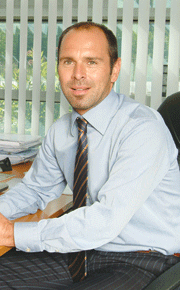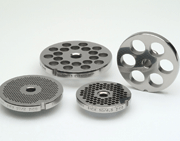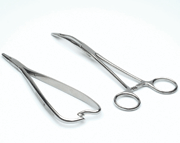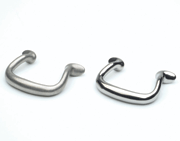E-Archive
Good Vibrations
in Vol. 8 - September Issue - Year 2007
Vibratory Finishing Job Shop Centers And Their Manifold Ways To Make Customers Happy… (Part 2)

Good Vibrations Dirk Gather, Contributing Editor MFN and Plant Manager Gleitschliffzentrum Oranienburg

Parts for the food industry

Polished Surgical Instruments

Polished decorative parts
The broad range of mass finishing operations used in daily business of job shop centers can offer technical solutions satisfying nearly all requirements. In the May Issue of MFN we informed about standard applications. Today we want to give an introduction into the field of special applications and their advantages.
When companies ask for innovative mass finishing solutions for their products, they expect a broad range of functional and decorative surface finishing applications. Burr removal, grinding and smoothing, high end polishing operations are only some of the various possibilities. In this issue we want to give more information about this development to interested MFN readers.
Today the requirements with regard to the surface quality of a workpiece are often so high that some years ago everybody would have thought their realisation in serial production impossible - or that no technical solution for industrial production would be available. This situation has changed!
The development of different technologies and methods make a number of different solutions for the fulfilment of functional and decorative surface requirements possible.
Parts of almost every size as well as all kinds of parts for small series and mass production can be processed satisfying highest quality requirements. Process stability and continuously high (reproduction) quality can be guaranteed.
The modern and innovative mass finishing applications of today are totally different from the technologies of earlier days. Besides modified machinery and equipment, new kinds of grinding or polishing consumables, new chemical additives or special agents are used to support the process.
The results are an improvement in quality, a higher economic efficiency as well as an optimized use of production capacities.
What does this mean in detail? There are some interesting aspects:
Quality - Some users continue to think that the mass finishing process can only be used as a step of rough surface treatment between the mechanical production of a part and its high end surface finish (polishing, plating or coating). However, today’s mass finishing technologies, as offered by well equipped job shop centers, can mostly be described as complete final finishing operation steps. For example, using vibratory finishing machinery in combination with paste-like additives and polishing compounds it is possible to achieve high end decorative or functional surfaces.
In some cases these surface finishing applications can make the final electro-plating process unnecessary. That shows not only interesting technical aspects but also economic advantages.
For manufacturers there are almost no limits with regard to the utilisation of these innovative technologies. Decorative parts such as jewellery, high-grade metal fittings, components for spectacles, decorative automotive parts, design objects and many more can be processed in a very effective way.
Progressive mass finishing technologies must be considered not only for decorative but also for functional surfaces. If the characteristics of friction and wear are quality aspects of parts, the improvement of the surface structure constitutes interesting benefits. Some of the special but well known technologies, such as the Keramo-Finish-process (Rösler Company) or the ISF process (REM Chemicals, Inc.) may reduce the surface roughness down to Ra 0.02µm.
These dimensions of surface improvement cannot be achieved with conventional mechanical operation methods. However, standard solutions are not available off the peg. Rather, an ideal combination of equipment and process has to be developed. For this, all aspects with regard to quality, quantity and production requirements need to be considered. In order to find the best solution, an intensive communication between the manufacturer and the mass finishing supplier is necessary. All the important aspects concerning quality demands, production volume and price have to be discussed to find a decision about the suitability of a specific mass finishing process.
Efficiency – An improved efficiency of mass finishing processes can be reached primarily by two factors: Firstly, optimizing technical aspects and the machinery used (i.e. high speed vibrators); secondly, using specific products, which accelerate the technical process. Today it is possible to reduce process time by 50% using different methods.
Efficiency is also influenced positively, when several process steps, i.e. burr removal, grinding, polishing/finishing, which were traditionally carried out on different machines, can be reached in just one or maybe two steps using one machine.
The improved market possibilities of mass finished products are particularly interesting. In many industries, i.e. the medical field (implants), the automotive after market (alloy wheels) or the engine units (driving gears, gearing elements), products with a mass finished surface can be sold more successfully, which in return reflects on the economic situation of a company.
Using today’s possibilities of automation it is even possible to control fully automatically mass finishing processes consisting of several steps or linked machines. Thereby a high degree of optimization can be achieved. Combined with an innovative process technology, efficiency can reach a new dimension.
Capacities – In order to optimize the use of existing machine capacities without further investment one needs to consider the above mentioned aspects. The result of faster processes are vacant capacities. Automation can increase the available production time. Service providers who react accordingly and offer specialized processes, can offer manifold and more flexible solutions and have a better performance – a benefit to both, service provider and customer.
The possibilities of modern mass finishing technologies are not restricted to some important areas. Therefore, there has been no mentioning of specific areas. The exchange of detailed information and a clear definition of expectations enables a dialogue between producer and the supplier of mass finishing equipment. The result of this communication process is the development of a technical solution convincing both sides. The question whether the final process will be offered by a service provider or whether the producer of parts will make the parts themselves using own equipment is secondary.
by Dirk Gather
Good Vibrations
by Dirk Gather,
Contributing Editor MFN
and Plant Manager
Gleitschliffzentrum Oranienburg
Tel. +49.3301.5232.0
Fax +49.3301.5232.29




























